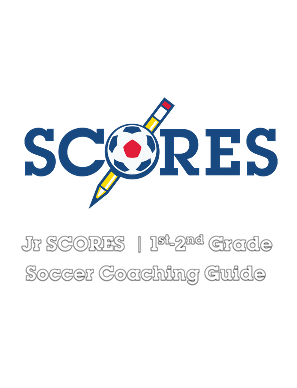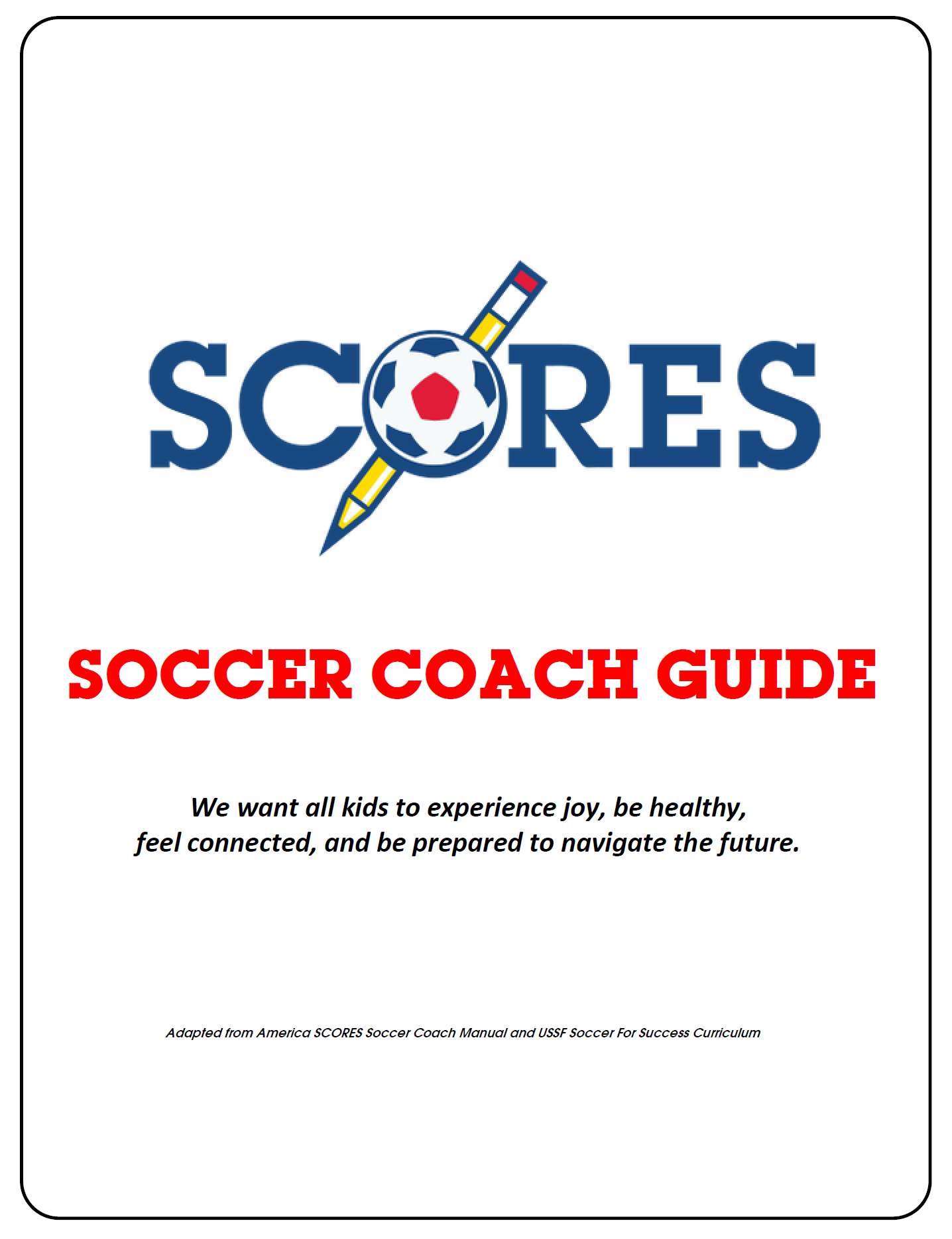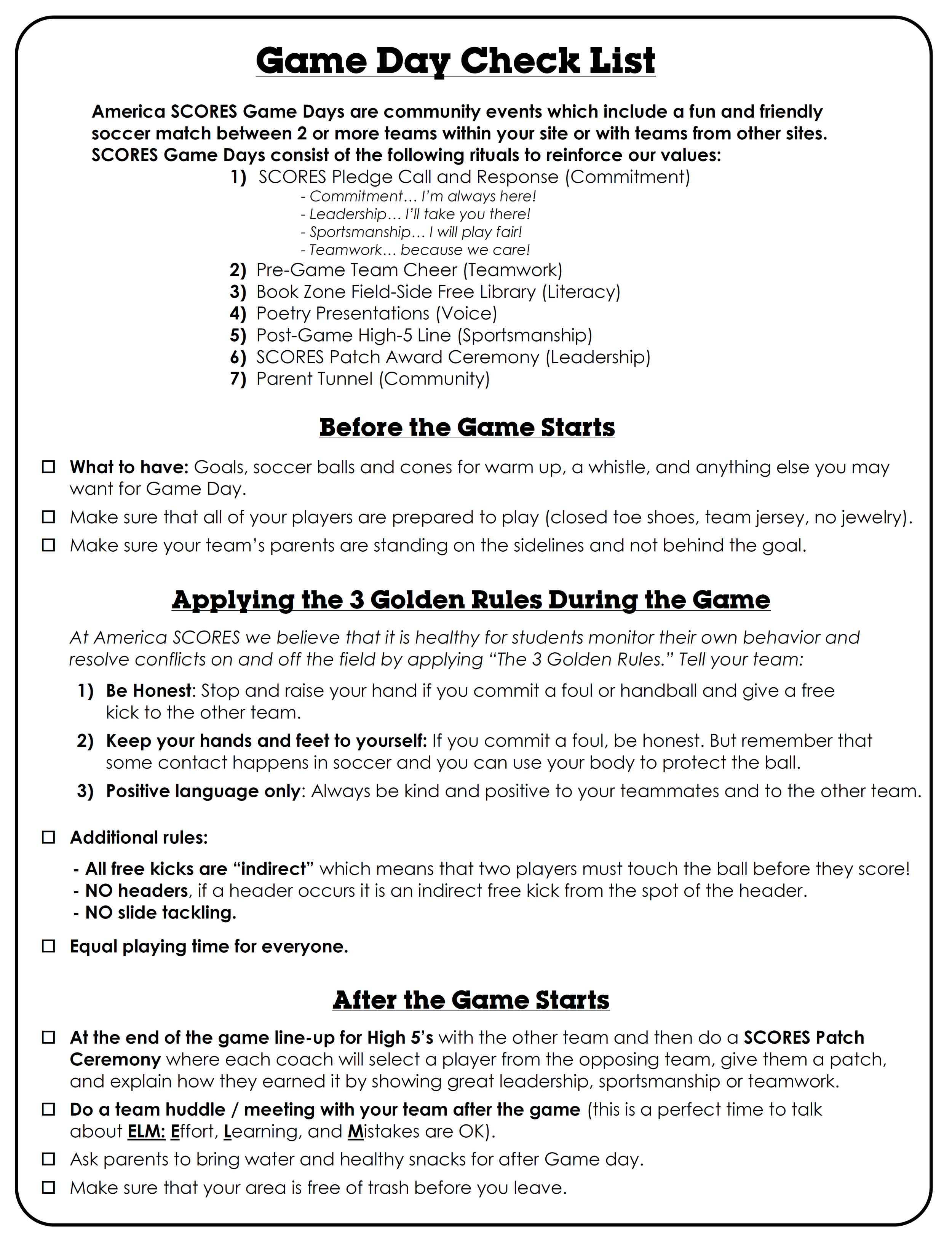SOCCER
🤝🙌💪😃
As SCORES soccer coaches, we are teachers, mentors, role models, and cheerleaders…
and we’re all still learning every day. SCORES coaches build strong relationships with students and create a fun, safe, and inclusive team culture.
In this section, you’ll find coaching resources including videos and practice plans with fun games and skill-building activities that will help you plan great practices.
Let’s coach with patience, persistence, and love for the beautiful game!
SCORES SOCCER CULTURE
-
The “SCORES Pledge” call and response:
COMMITMENT — I’m always here!
LEADERSHIP — I’ll take you there!
SPORTSMANSHIP — I will play fair!
TEAMWORK — Because we care! -
We believe that EFFORT and IMPROVEMENT are more important than winning or losing.
SCORES Poet-Athletes consistently give great effort, continually learn, and resiliently bounce back from mistakes. To help us remember this, we use the ELM Tree of Success:
E is for Effort
L is for Learning
M is for Mistakes are OK.
* Adapted from Positive Coaching Alliance framework
We recognize that soccer is a competitive sport. We know that keeping score is part of the game. But as coach-mentors, we strive to de-emphasize the score and focus more attention on our team’s effort and growth, and their ability to support each other and overcome setbacks.
-
By teaching soccer skill using the SAFE method you will enhance and accelerate your Poet-Athletes’ skill development.
Effective skill-building instruction uses the acronym SAFE:
S. Sequenced — Instruction is planned in a series of connected and coordinated steps so that skills build upon each other and are strengthened over time.
A. Active — Instruction uses active forms of learning to help students master new skills.
F. Focused — Time and attention is devoted to developing individual skills. The skill-building time is intentional and includes plenty of repetitions and practice for each Poet-Athlete.
E. Explicit — Instruction targets a specific skills and students are made aware of what they are learning and practicing.
-
SCORES Coaches coach with FIRE.
F. FOSTER YOUTH VOICE
Let them choose and solve problems. For instance, allow them to choose between different activities or ask how they would overcome specific challenges.I. INSPIRE WITH ENCOURAGEMENT
Provide positive feedback and encourage frequently. Be sincere and focus on what they do right. Highlighting the good work can motivate them to keep improving.R. RESPECT & REWARD
Value their thoughts, reward effort and proper technique, not just outcomes—praise not only the results but also the process and dedication.E. ENGAGE WITH ENTHUSIASM
Your enthusiasm fuels their passion. Smile, interact, and listen. Your energy and genuine interest in their development will create a positive connection.A coach’s role is more than teaching skills. It is about lighting the fire of passion, self-belief, and joy. So, stay ignited, and keep our Poet-Athletes fired up!
*This coaching framework was developed by Total Uplift.
-
When you involve children in the decision-making process of any activity it will help them to make the best choices for their individual development. Here are some coaching strategies that you could build in to your sessions.
Design an activity that has three levels of progression where Poet-Athletes can choose the right challenge for them.
Can you introduce activities or games that encourage Poet-Athletes to problem solve in multiple ways to suit their abilities and interests?
During an activity within your next session, only ask questions, rather than giving instructions and directions.
Create a time within each session for your Poet-Athletes to choose their next activity.
Make space within a session for your Poet-Athletes to create or co-create activities that can then be played.
These tips and suggestions were adapted from resources at playtheirway.org
-
At the end of each session, make time and create a safe space for reflection. CLICK HERE and review our End of Session Reflection Guide with tips and best practices for facilitating reflection discussions.
PRACTICE STRUCTURE & PLANNING
-
Play-Practice-Play is a philosophy and practice structure that allows young players to experience the game and game-like situations as much as possible.
This approach differs from traditional practices that may have children standing in lines, running laps and participating in drills that don’t resemble the game of soccer.
TEAM CHECK-IN (2-5 MINUTES)
Announcements / Focus of the Day / Reminders
1️⃣ STAGE 1: PLAY
When players arrive to practice, the first responsibility of the coach is to create an environment that is safe, engaging and fun. In the first Play phase, players engage in small-sided games with the primary focus on having fun.
It is important that these pickup-style games are led by the players and facilitated by the coaches. During this first Play stage, players have the opportunity to experience the game while the coach observes and guides them towards developing their own solutions rather than being directed what to do.
2️⃣ STAGE 2: PRACTICE
In the second phase of Play-Practice-Play, children are engaged in different forms of targeted learning activities to further guide their opportunities to develop. The goal of the Practice phase is to create an environment filled with opportunities for players to experience and learn about the goal of the training session through repetition.
Practice activities should have the appropriate level of challenge (striking a balance between success and failure), resemble the game, involve the players making decisions and allow for creative problem solving. The role of the coach during this phase is to guide players while using teaching actions. While it is during this phase that targeted learning takes place, there should always be an emphasis on keeping the atmosphere fun and enjoyable for the players.
3️⃣ STAGE 3: PLAY AGAIN!
The final stage of Play-Practice-Play is the game. This phase offers players the opportunity and freedom to play, without interruption, in an environment that mirrors the actual game. The focus of the final Play phase is to encourage players to express themselves and demonstrate what they learned during the Practice phase.
A coach should observe and guide using minimal talking if possible. By silently observing the application of the Practice phase in the final Play phase, the coach is able to check each player’s understanding and ability to execute the goal of the training session.
TEAM CHECK OUT (5 MINUTES)
Reflection (CLICK HERE FOR A TIP SHEET) / Appreciations / Reminders
Click here to check out the US Soccer Grassroots Roadmaps which offer guidance on how to teach the important concepts and principles of the game to young players.
-
5 STEPS OF A SOCCER PRACTICE
STEP 1 — Team Check-In (2-5 minutes)
- Announcements / Focus of the Day / RemindersSTEP 2 — Warm-Up & Team-Building (5-10 minutes)
STEP 3 — Skill-Building Activities & Games (20-25 minutes)
STEP 4 — Soccer Scrimmage (10-15 minutes)
STEP 5 — Team Check-Out (2-5 minutes)
- Reflection (CLICK HERE FOR A TIP SHEET) / Appreciations / Reminders -
REVIEW THE 5 STEPS FOR A SOCCER PRACTICE
CHOOSE YOUR ACTIVITIES
from our library of coach guides, videos, and suggestions for warm ups, games, and skill-builders further down on this page.
WRITE DOWN YOUR PRACTICE PLAN
on the blank 5 Steps for a Quality Soccer Practice Planning Sheet, or you can write down your plan on any blank piece of paper.
PUT IT IN YOUR POCKET!
Fold it up and put it in your pocket. Look at it right before practice and during water breaks to remember your plan and keep your practice on track!
MOJO SPORTS VIDEO LIBRARY
MOJO Sports has an outstanding library of activities and games with high-quality videos explaining each activity.
REVIEW THE 5 STEPS FOR A SOCCER PRACTICE on our 5 Steps for a Quality Soccer Practice tips sheet.
CHOOSE YOUR ACTIVITIES from our library of coach guides, videos, and suggestions for warm ups, games, and skill-builders on this page.
WRITE DOWN YOUR PRACTICE PLAN on the blank 5 Steps for a Quality Soccer Practice Planning Sheet, or you can write down your plan on any blank piece of paper.
PUT IT IN YOUR POCKET! Look at it right before practice and during water breaks to remember your plan and keep your practice on track!
SOCCER 101
DRIBBLING ACTIVITIES
PASSING ACTIVITIES
SHOOTING ACTIVITIES
SCRIMMAGES
GOALIE ACTIVITIES
COACHING GUIDES
Use these coaching guides to get ideas, games, tips, and activities that will help your team develop skills, confidence, and teamwork.
REVIEW THE 5 STEPS FOR A SOCCER PRACTICE on our 5 Steps for a Quality Soccer Practice tips sheet.
CHOOSE YOUR ACTIVITIES from our library of coach guides, videos, and suggestions for warm ups, games, and skill-builders on this page.
WRITE DOWN YOUR PRACTICE PLAN on the blank 5 Steps for a Quality Soccer Practice Planning Sheet, or you can write down your plan on any blank piece of paper.
PUT IT IN YOUR POCKET! Look at it right before practice and during water breaks to remember your plan and keep your practice on track!

























































































